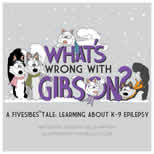New anticonvulsant drugs show promise in dogs, cats
Mar 1, 2008
By: Johnny D. Hoskins, DVM, PhD, Dipl. ACVIM
![]()
A: Dr. C.W. Dewey gave an excellent lecture at the 2007 American College of Veterinary Internal Medicine Forum on "Recent and Upcoming Developments with the New Anticonvulsant Drugs." Here are some relevant points:
During the past 10 to 15 years, a number of new anticonvulsant drugs have been introduced for the treatment of human seizure disorders, some of which have been shown to be safe and effective for use in dogs. These drugs include gabapentin, felbamate, zonisamide and levitiracetam.
These anticonvulsant agents currently are used as an "add-on" drug for dogs with refractory seizure disorders. With the exception of levitiracetam, information on the use of such drugs in feline seizure disorders is anecdotal. But as these drugs get older and begin to emerge as less-expensive generic products, their clinical applicability in veterinary medicine continues to expand.
In general, these drugs have fewer side effects than the standard drugs, phenobarbital and potassium bromide, and are being considered more frequently as first-line anticonvulsant therapy for canine epilepsy. In addition to expanded use as maintenance anticonvulsant agents in dogs (and to a lesser extent in cats), two of these drugs (levitiracetam and zonisamide) have potential use in emergency settings (i.e., for status epilepticus and cluster seizures).
![]()
New anticonvulsant drugs
Gabapentin appears to exert its anticonvulsant effect primarily via interaction with neuronal voltage-gated calcium channels. Inhibition of these channels is thought to decrease excitatory neurotransmission. Gaba-pentin typically is administered orally at a dosage of 10 mg/kg every eight hours in dogs. There are anecdotal reports of gabapentin use in cats with seizures (5-10 mg/kg PO, q8-12 hours).
Clinical efficacy reports in refractory epileptic dogs treated with gabapentin as an add-on therapy indicate that fewer than half of such dogs are responders (i.e., experience a 50 percent or more reduction in seizures after adding gabapentin). However, gabapentin is the least effective of the new anticonvulsant drugs. Side effects typically are mild, and include minor sedation and pelvic limb ataxia.
Gabapentin is available in generic form at a much lower price than the trade-name formulation.
Felbamate is suspected to exert its anticonvulsant effects via potentiating GABA-mediated neuronal inhibition, mitigating NMDA-mediated neuronal excitation and inhibiting voltage-gated neuronal sodium and calcium channels.
Felbamate typically is dosed initially at 15 mg/kg orally every eight hours. There is limited published information regarding its efficacy, but it is generally believed to be an effective anticonvulsant add-on agent. Side effects are uncommon, but hepatotoxicity (usually with concurrent high phenobarbital blood levels), reversible blood dyscrasias and keratoconjunctivitis sicca have been reported with felbamate use in dogs. There is no information on its use in cats.
Considering the hepatic and blood dyscrasia issues associated with felba-mate use in humans and dogs (uncommon as they may be), it is unlikely that there will be much impetus to pursue research into feline felbamate use. There is no generic formulation available for felbamate.
Levitiracetam has been shown to have a unique intracellular binding site, a synaptic vesicle protein (SV2A), the affinity of binding to which appears to be correlated with the drug's anticonvulsant potency. Binding to SV2A affects neurotransmission via interactions between synaptotagmin and calcium ions, but the precise biochemical pathways remain undetermined.
Levitiracetam is an attractive anticonvulsant option due to its lack of side effects and favorable pharmacokinetic profile (e.g., no hepatic metabolism, 100 percent oral bioavailability, no drug-drug interactions). There is limited published information regarding its efficacy as an add-on anticonvulsant in dogs, but so far it is favorable. The dose usually used is 20 mg/kg orally every eight hours. A lower-cost, generic form of oral levitiracetam is available.
Zonisamide has proven to be an effective add-on anticonvulsant drug in dogs, with few side effects. There are multiple proposed mechanisms of action for zonisamide, including blockage of T-type calcium and voltage-gated sodium channels in the brain, facilitating dopaminergic and serotonergic neurotransmission, free-radical scaven
Considering the hepatic and blood dyscrasia issues associated with felba-mate use in humans and dogs (uncommon as they may be), it is unlikely that there will be much impetus to pursue research into feline felbamate use. There is no generic formulation available for felbamate.
Levitiracetam has been shown to have a unique intracellular binding site, a synaptic vesicle protein (SV2A), the affinity of binding to which appears to be correlated with the drug's anticonvulsant potency. Binding to SV2A affects neurotransmission via interactions between synaptotagmin and calcium ions, but the precise biochemical pathways remain undetermined.
Levitiracetam is an attractive anticonvulsant option due to its lack of side effects and favorable pharmacokinetic profile (e.g., no hepatic metabolism, 100 percent oral bioavailability, no drug-drug interactions). There is limited published information regarding its efficacy as an add-on anticonvulsant in dogs, but so far it is favorable. The dose usually used is 20 mg/kg orally every eight hours. A lower-cost, generic form of oral levitiracetam is available.
Zonisamide has proven to be an effective add-on anticonvulsant drug in dogs, with few side effects. There are multiple proposed mechanisms of action for zonisamide, including blockage of T-type calcium and voltage-gated sodium channels in the brain, facilitating dopaminergic and serotonergic neurotransmission, free-radical scavenging, enhancing GABA activity and decreasing glutamate-mediated processes.
Dogs concurrently receiving pheno-barbital therapy tend to require a higher zonisamide dose (10 mg/kg, q 12 hours) than dogs not receiving phenobarbital (5 mg/kg, q 12 hours). The BID dosing schedule for zonisamide is an advantage over the other new anti-epileptic drugs for many dog owners. It is available in the generic form.
As sole drug therapy
There are a number of reports in human medical literature supporting the use of some of these new anticonvulsant drugs as sole therapy. Because they have minimal side effects, they may offer an advantage over more standard drugs used in dogs. And, as the price decreases for generic versions, there will be more opportunities to use these newer agents as standard therapy, especially in small-breed dogs.
Anecdotally, felbamate can be used as a sole anticonvulsant drug. In most cases, it is used to avoid the side effects of phenobarbital or potassium bromide. Such cases include the management of disorders in which the underlying disease and its treatment may result in worsening clinical signs with the addition of standard anticonvulsant drugs (e.g., obtunded brain tumor and GME dogs receiving prednisone).
In addition, dogs with suspected idiopathic epilepsy have been treated with zonisamide as a sole anticonvulsant drug. It appears to perform well as a sole anticonvulsant drug for canine idiopathic epilepsy.
New feline anticonvulsant drugs
Until recently, the only anticonvulsant drug known to be safe and effective for feline use was phenobarbital. The use of gabapentin for seizures in cats remains anecdotal, with unproven efficacy. Due to the length of time that such anecdotal use has been discussed in the veterinary literature (with no reports of serious side effects), and the known safety of the drug in other species (i.e., humans, dogs), it is likely to be a safe drug in cats.
Levitiracetam has been used as an add-on (to phenobarbital) oral anticonvulsant drug in a few cats with suspected refractory idiopathic epilepsy. It was found to be an effective add-on anticonvulsant, and serum levitiracetam levels are maintained within the therapeutic range reported for people (5-45 ug/mL) using a 20 mg/kg every 8 hours dosing regimen. Side effects are limited to transient (one to two weeks) lethargy and inappetence; these resolved without adjusting drug dosage.
Levitiracetam can be used as second-line anticonvulsant drug choice for cats poorly controlled with phenobarbital alone.
Emergency seizure management
The current standard of care for treating dogs with cluster seizures or status epilepticus is to administer highly sedative drugs to halt seizure activity. As diazepam often fails in these animals, the induction of a light plane of anesthesia using barbiturates or propofol often is required.
In addition to posing some risk, it may be difficult or impossible to add additional maintenance anticonvulsant drugs to the treatment protocol during this time period.
Both intravenous levitiracetam and intra-rectal zonisamide hold potential as useful emergenLevitiracetam can be used as second-line anticonvulsant drug choice for cats poorly controlled with phenobarbital alone.
 A commercial form of intravenous levetiracetam was recently introduced. A single-dose pharmacokinetic study with this drug formulation in normal dogs, using an intravenous bolus dose of 60 mg/kg over two minutes, showed no apparent side effects and all dogs reached and maintained plasma levitiracetam concentrations within or exceeding the therapeutic range reported for humans for the entire eight-hour evaluation period.
A prospective clinical evaluation of intravenous levitiracetam use in dogs with cluster seizures and status epilepticus is under way.
Newer versions
Recent insights into the mechanisms of action of two of the new anticonvulsant drugs (gabapentin and levitiracetam) have generated developments of the next generation drugs with increased anticonvulsant potency.
The successor to gabapentin is pregabalin, which has greater affinity for the voltage-gated calcium channels than its predecessor. There are two successors to levitiracetam — brivaracetam and seletracetam — both of which have greater affinity for SV2A than levitiracetam.
Because of the problems of hepatotoxicity and blood dyscrasias occasionally associated with felbamate use in people, a new derivative of the drug, fluorofelbamate, has been developed. The substitution of fluorine for hydrogen in a critical place in the molecule is believed to prevent the formation of the toxic metabolite responsible for the reported side effects.
All of these drugs appear to have greater anticonvulsant activity in experimental rodent models than their predecessors. Pregabalin also has shown greater anticonvulsant efficacy than gabapentin in people. Brivaracetam, seletracetam and fluorofelbamate are in clinical trials. Pregabalin is commercially available, but the appropriate dose regimen for oral pregabalin in dogs is still unknown.
Dr. Hoskins is owner of Docu-Tech Services. He is a diplomate of the American College of Veterinary Internal Medicine with specialities in small animal pediatrics. He can be reached at (225) 955-3252, fax: (214) 242-2200 or e-mail: jdhoskins@mindspring.comPage last update: 07/18/2011










